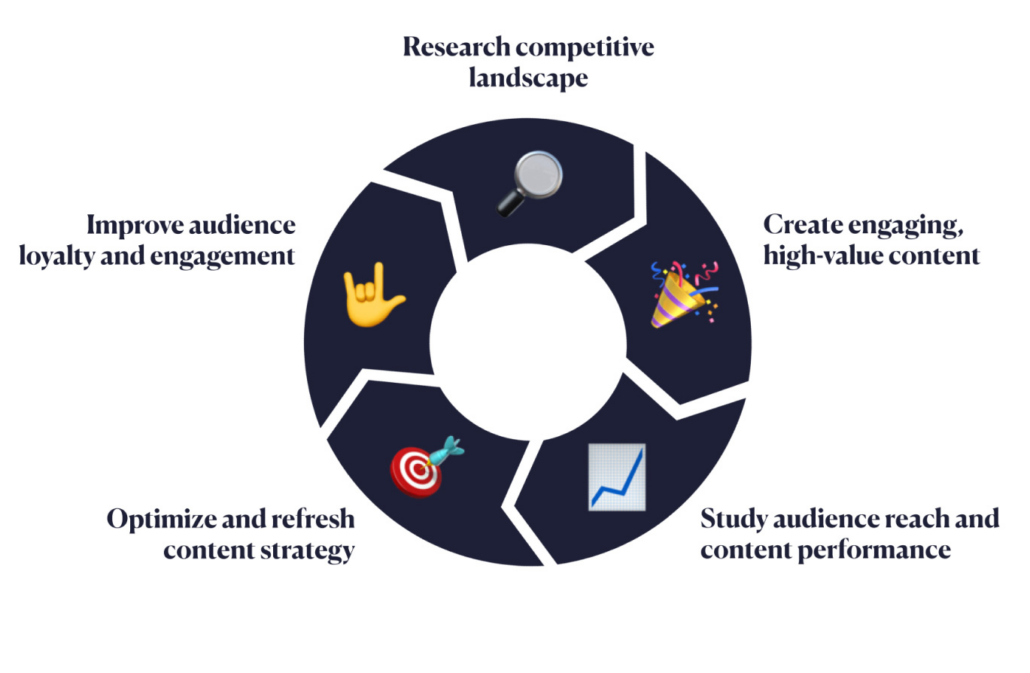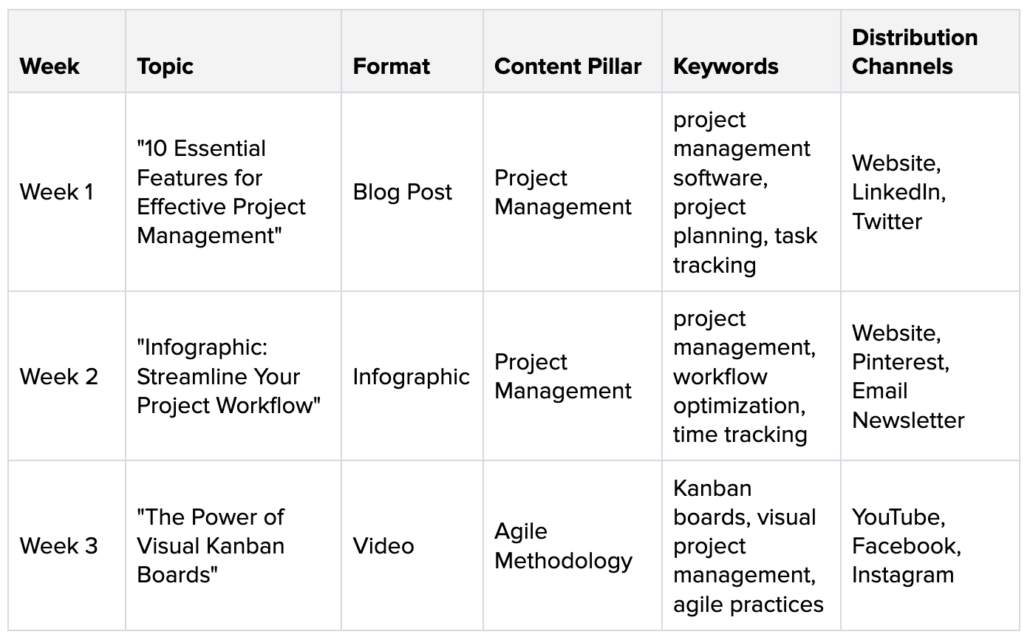Optimizing Your Content Marketing Strategy for High-Quality Lead Generation

Long story short: Look at the numbers. A data-driven content marketing strategy has emerged as a necessity for businesses aiming to attract qualified leads from organic search. By dissecting customer data and conducting meticulous research, marketers have the capacity to curate compelling and valuable content that profoundly resonates with the target audience.
This thoughtful approach not only encourages meaningful engagement but is also designed to convert leads into devoted customers. The process of turning data into dineros unfolds through four key steps:
- Research
- Strategy
- Activation
- Optimization
With a glimpse of how content marketing fuels organic lead generation, let’s turn our attention to the specific insights that will form the foundation for engaging, data-driven content (and remarkable results).
1️⃣ Research
What’s the best (and only) way to get the data that will serve as the foundation for your content strategy? Research, research, and more research. Qualitative and quantitative, hard and soft–now’s the time to follow your curiosity and find out everything you can about your audience, what makes them tick, where to find them, and what they need.
Audience Research: Identifying Your Target Audience
Before starting the content creation process, you must clearly define your ideal customer profile(s) (ICP). By developing a detailed understanding of your target audiences, you can tailor your content to their preferences, pain points, and aspirations.
Creating Customer Personas
Craft detailed profiles that include demographic information, interests, behaviors, and goals of your target audience segments. This will help you empathize with your audience and create content that answers their questions, addresses their needs, and starts to connect the dots between their pain points and your solutions. The more your audience feels you understand them, the easier it will be to build trust.
Conducting Customer Research
Utilize as much first-person and third-party data as you can to gather insights into your audience’s needs, challenges, and motivations. By delving deeper into their preferences, you can better understand what type of content will resonate with them. Try these tactics to jumpstart your research process:
- Surveys: Utilize surveys to gather valuable first-hand anecdotes and preferences.
- Customer Interviews: If possible, meet with customers or prospects to get a better understanding of their goals, pain points, and what they want from a product or service like yours, so you can tailor your content accordingly.
- Collab with Customer Support and Sales Teams: Engage closely with your client-facing teams to gather valuable feedback from customer conversations, allowing you to identify opportunities for improvement, where customers need the most help, and what trending topics come up frequently.
- Case Studies and Testimonials: Research is a great catalyst for collecting case studies and testimonials from satisfied customers. You’ll be able to build trust with potential customers by getting specific about their needs and how your company addresses them. ABTSA: Always be 2 steps ahead!
- Competitor Intel: Conduct thorough competitor analyses to understand the competitive landscape, identify your unique selling points, and differentiate your offerings, enabling you to position your company strategically in the market and in front of your audience.
Conducting thoughtful customer research sets the foundation for a strong content strategy aimed at generating quality leads. By leveraging what you know about your audience, you have the fuel to make informed decisions when planning content that speaks directly to what they care about. An audience-centric approach is the KEY🔑 to a successful content strategy that brings in the right leads at the right time. But there are more ways to get to know your audience and the information they seek, which is why we turn to keyword research to learn more.
GA4 and Keyword Research: Identifying Organic Search Opportunities
At Tuff, we know that creating content that truly captures the attention of your target audience requires a deep understanding of not only their preferences, but also their behavior. By leveraging search and keyword data, we can craft content that will live a long, happy life online. Meaning – search engines can find it, your audience can use it, and it remains relevant and useful for weeks, months, years (?!) after publish. By combining metrics from GA4 and keyword research, you can uncover what you need to build an SEO-friendly content strategy. Here’s a good place to start:
- GA4 Analysis
- GA4, the latest version of Google Analytics, offers advanced features/measurement that provide a comprehensive view of your website and marketing performance.
- Use GA4’s enhanced measurement to track user interactions and behaviors across multiple devices and platforms. providing a holistic understanding of your audience’s journey. Through that holistic view, you can identify patterns and trends that can guide your content strategy.
- Leverage audience insights from GA4 to understand user demographics, interests, and engagement patterns. Then, segment your audience and tailor your content to their specific needs and preferences.
- Content Performance: Analyze the effectiveness of your keywords by tracking key metrics such as page views, bounce rates, and time on page to see how your audience (or audience segments) interact with your content.
- Conversion Tracking: Multi-touchpoint conversion tracking can help you better understand which keywords and content contribute to conversions at each point in your audience’s journey.
- Keyword Research
-
- Conduct keyword research using tools like Ahrefs or SEMrush to discover “hot” topics aligned with your audience’s search behavior. Check out search volume, keyword difficulty, and related terms and find the right balance of high demand and low competition to fill your keyword gaps.
- Pay special attention to the intent behind popular search queries. Rather than focusing only on the words they search, try to understand their motivations, pain points, and desired outcomes when searching to get to the root of their needs.
- Monitor your website’s SEO performance, tracking keyword rankings, organic traffic, and click-through rates. Use that data to refine your plan and continue to optimize for your audience, their needs, and the actions you want them to take.
By integrating these data points, you can develop content ideas that both engage your audience and are also rooted in real behavior metrics. This data-driven approach will enable you to create highly engaging content that resonates with your target audience. This level of planning, when done right, will attract relevant traffic, increase visibility, and build long-term site authority. As we move onto the next section, we’ll discuss turning these data points and trends into a practical, usable, data-drenched content strategy. Let’s do this.
2️⃣ Building a Content Strategy
Building Content Pillars
After conducting your initial research, you’ll have uncovered and collected relevant topics and themes that align with your audiences’ search behavior. You’ll have enough data to identify your top target keywords, which will form the basis for developing content pillars that address your audience’s interests and challenges.
Content pillars are a fundamental aspect of any successful content strategy. They serve as the backbone of your plan, guiding your content production and ensuring consistency and relevance across everything you produce. By organizing your content around central pillars (think: themes), you establish your website as a reliable and authoritative source for specific information, boosting your credibility for search engines and in the eyes of your audience.
Creating content pillars based on search and audience data lets you organize and optimize your content for search engines while providing valuable info to your audience. It’s a strategic approach that not only improves your SEO performance but also establishes your expertise and builds trust with your readers.
Identifying the Right Promotion Channels
Choosing the right distribution channels is a critical aspect of developing a successful content strategy. Here’s how you can determine which channels will drive quality leads:
- Historical Performance: Revisit the performance of previous content you’ve published. Tap into key metrics such as engagement, conversion rates, and of course lead volume and quality. Identify the channels that are driving the highest quality leads and focus your efforts on developing content tailored to them.
- Audience Data: Use your audience research to select channels where they are most likely to be present and engaged. Assess the relevance of each distribution channel to your content and target audience. Are they Tiktok users vs. newsletter subscribers? Do they attend industry conferences or consume mostly digital content? Are they more likely to Google something or search Instagram for info?
- Industry Best Practices: Stay up-to-date on the latest industry trends and best practices for content distribution. Look for successful case studies and examples of companies that share a similar target audience and see what their publishing patterns look like. What do their ads look like? Which blogs do they continue to promote month after month? That may give you an idea of their top-performing content.
- Start with Key Channels: Begin by focusing on a few key channels that have proven to be effective for your industry and/or target audience. Allocate your resources and efforts accordingly to maximize your impact on those channels. As you gain more insights and resources, you can scale to more channels and begin testing.
Scheduling and Logistics
This one’s for all the planners and organizers out there–logistics 🤓 A consistent content publishing schedule is key to maintaining audience engagement and building trust, two important factors in attracting and converting quality leads. Plan your content creation and publishing process in advance, allowing enough time for research, writing, editing, publishing, and optimization. To streamline the workflow, develop a comprehensive content calendar as your single source of truth. Include essential details like content pillars, topics, keywords, formats, distribution channels, and publication dates. This structured approach speeds up resource allocation, provides transparency, and sets the stage for a smooth and consistent development process.
When planning your timeline, make sure to incorporate repurposed content into your plan to extend its reach and lifespan. Transform existing content into various formats like videos, infographics, blogs, or social media posts. Reach new audiences and reinforce your message across channels without extra production time.
Here’s a snapshot example of a content calendar for a project management software company:
By implementing a comprehensive schedule, you can ensure that your content reaches the right audience at the right time through planned keywords, rich content, and optimized publishing channels. This naturally leads us to the next component of a strategic marketing plan: the funnel. Let’s talk about how we plan for content that guides prospects through each stage of the funnel, ultimately converting engagement into valuable leads.
Full-Funnel Content Marketing
At a glance, the marketing funnel consists of three sections:
- Top of the funnel (TOFU): Grab their attention
- Middle of the funnel (MOFU): Collect their contact info
- Bottom of the funnel (BOFU): Make the sale!
For your content to make sense to the audience, it must not only align with keywords and address pain points, but it must also match where your audience is in “user journey”. By mapping out the touchpoints your audience has with your brand (from TOFU to BOFU) you can tailor your content to address their needs along the way. It’s the data that tells us what they need when!
We lean on UX (User Experience) to guide the audience naturally to the next step of their journey. By offering opportunities for capturing contact information from interested visitors, you can nurture and convert them into paying customers over time. Strong calls-to-action (CTAs) play a key role in driving conversions. Place persuasive CTAs throughout your content, encouraging readers to take action and provide their contact details in exchange for information or resources.
By strategically incorporating these lead gen tactics into your content, you can optimize your content strategy to convert engagement into valuable leads.
Setting Goals
To prove the success of your content marketing efforts, establish benchmarks and goals from the start. All goals should be specific to your brand and ladder up to business objectives, whether they’re increasing brand awareness, driving website traffic, generating leads, or a combination of all three. Whatever you choose, it’s crucial to proactively define your objectives and key performance indicators (KPIs) to track and evaluate your progress. Setting specific, attainable, and time-bound goals will help you stay focused and measure the success of your content efforts. Here are three examples of tangible goals, broken down into two phases (think: crawling and walking) to get you started:
Example Goal 1: Increase monthly website traffic
Drive more potential leads to the website by increasing the number of unique visitors. Expanding brand visibility and attracting a larger audience to the website increases the potential for lead generation and future conversion opportunities.
- Phase 1: Increase unique visitors by 20% (compared to the previous month).
- This will be our initial benchmark to gauge progress and assess the effectiveness of the content strategy in attracting a larger audience.
- Phase 2: Increase organic traffic by 30% (compared to the previous quarter).
- The emphasis shifts to increasing organic traffic to the website within a quarterly time frame. This will tell us about the content’s ability to rank higher in search engine results and attract more qualified leads.
Example Goal 2: Improve lead quality through content
Attract high-quality leads by creating content that addresses their pain points, offers valuable insights, and positions the company as an industry thought leader.
- Phase 1: Increase average time spent on site by 15% (compared to the previous month).
- The focus is on engaging visitors through better site UX and content. A longer time on the site signals a higher level of interest and better lead quality.
- Phase 2: Increase conversion rate by 10% (compared to the previous quarter).
- A higher conversion rate signifies that the content effectively convinces and motivates visitors to take the desired actions, indicating better lead quality.
Example Goal 3: Expand email subscriber base
Grow the email subscriber list to nurture into a loyal audience. A larger subscriber base provides a direct communication channel for further qualifying leads and driving conversions.
- Phase 1: Increase email subscribers by 25% (compared to the previous month).
- Attract more sign-ups through successful lead generation content and improved UX.
- Phase 2: Improve email open rate by 10% (compared to the previous quarter).
- The objective is to optimize email content and subject lines to increase open rates. A higher open rate indicates greater engagement and interest among email subscribers, resulting in better lead quality and potential conversions.
By focusing on increasing website traffic, improving lead quality, and expanding the subscriber base, your content strategy can achieve clear, measurable, and attributable results that directly impact the bottom line. With that data, you’re able to provide a better roadmap for attracting more potential leads, nurturing them through engaging content, and ultimately converting them into customers.
As we’ve discussed in this section, you have the opportunity to address your audience’s pain points throughout their journey. By utilizing keyword and audience data to create content pillars, you can spark your audience’s interests and acknowledge their challenges. Choosing the right promotion channels and establishing a consistent publishing schedule allow you to systematically fill in the content gaps on your website while giving your audience exactly the information you KNOW they need. Setting specific goals and KPIs sets you up to prove the impact your content has before you even hit the launch button. That’s up next ➡️
3️⃣ Activating Your Data-Driven Content Strategy
Writing Content for SEO
Simply put, the best content empathizes with the audience’s pain points and provides practical solutions that just so happen to be related to your product or service. Show up where they’re searching, educate and inform, offer solutions, and collect leads. It’s as easy as that 😉
To make sure your blogs and videos and infographics and whatnot reach the right audience, they all must be optimized for search engines. By employing basic SEO best practices, you can increase your content’s visibility and attract people (re: qualified leads) actively searching for solutions related to you.
SEO Writing 101
Start by including your target keyword in the post title, preferably at the beginning, and mention the target keyword early in the article (ideally in the first sentence). Reinforce it naturally throughout the content, aiming for at least five mentions while maintaining a healthy keyword density of 1-3% (so if your article is 1,000 words, 10-30 of those words should be keywords). Don’t forget to incorporate related keywords to expand the scope of your content and cover various aspects of the topic that users might be interested in.
To add links to your blog, prioritize a methodical internal and external linking strategy. Avoid too many consecutive paragraphs without links, as it can negatively impact user experience and SEO. Include at about five internal links in each piece of content with keyword-optimized anchor text. Be mindful not to link to another page with the primary keyword you want to rank for, even internally. Distribute the links naturally and ensure they are all working properly.
Don’t forget readability! Use subheadings to break up the text, keep paragraphs concise (3-5 lines), and optimize images with keyword-optimized alt tags. Maintain a natural flow without keyword stuffing, and remember that online readers prefer shorter sentences and dislike large blocks of text. Include an enticing call to action or clear next steps to inspire action.
When writing, focus on providing value, solving problems, and delivering a seamless user experience to attract the right leads and improve quality overall.
Publishing
A well-executed publishing process is absolutely crucial in activating and maintaining a strong content strategy. It ensures that your content gets to your audience consistently, maximizing its impact and driving the greatest possible engagement. With the content calendar as your guide, you have a clear plan of action already in place. There are quite a few considerations to make before launch:
Start by establishing clear workflows and responsibilities. By defining roles upfront, everyone knows their tasks and deadlines, preventing bottlenecks and reducing errors or delays. Streamlining the workflow promotes collaboration and accountability across content creation, editing, proofreading, and publishing. The less time you spend on logistics, the more you can spend on the content and strategy itself.
Maintaining editorial standards ensures that your content reflects your brand’s voice, style, and mission, building trust and reinforcing your brand identity. Implementing a review and approval process guarantees quality control and accuracy, ultimately upholding the quality of content you produce. Leaning on automation tools, such as content management systems like WordPress, Drupal, Joomla, HubSpot CMS, or Adobe Experience Manager. These tools provide a range of features to support content creation, distribution, and scheduling, enabling you to efficiently manage and automate your content strategy. By implementing some or all of these tactics, you can enhance efficiency, maintain quality, and deliver excellent content to your audience!
Now, let’s move on to the best (okay I’m biased) part of the process: reporting and optimization, where we analyze our results and make data-driven adjustments to further improve our content. It’s coming full circle now!
4️⃣ Reporting and Optimization
Reporting
Like most aspects of growth marketing, your reporting process simply must be structured and consistent in order to demonstrate success. First things first, you should always revisit your goals and KPIs. Take the time to reassess what you set out to achieve with your content. For example, if your goal was to increase website traffic and conversions, your KPIs may include metrics such as page views, click-through rates, and conversion rates.
Quality ≠ Quantity
Next, pay attention to lead quality. To assess the quality of your leads, track their movement through (or out of) the funnel and collaborate with your sales team for additional context. They have valuable insights into the leads generated from your content and can provide first-hand feedback on the quality and conversion potential of leads your content has delivered. By working together, you can identify which content pieces are attracting high-quality leads that are more likely to convert into customers. This collaboration also helps ensure that your content aligns with the sales team’s objectives and that they have the necessary information to effectively nurture leads through the funnel. It’s a win-win 🤝
At the same time, make sure to assess the quality of your content itself. Look at metrics like engaged sessions in GA4, time spent on page, click-through rates, referrals, and bounce rates. These metrics provide insight into how well your content resonates with your target audience, captures their attention, and encourages further interaction. Further down the funnel, conversion metrics such as form submissions, newsletter sign-ups, and downloads, point directly to whether your content is generating those high-quality leads we’re after.
Once you have all that juicy data, it’s time to uncover patterns, trends, and highly specific audience preferences. This deeper understanding will help you plan and optimize for even more data-driven, targeted, and engaging content that resonates with your ideal audience even better than before.
Optimizing Your Content Strategy
To attract more qualified leads, refining and optimizing is the name of the game. Here’s how to jumpstart that process:
Double Down on Success 📈
When you discover content that performs exceptionally well in terms of lead generation and engagement, you’ll want to sprinkle that magic into more content. Identify the key elements that contribute to its success and replicate them in your next content plan. The more data you collect, the stronger your plans become (and the better your results!)
Make it an Ongoing Process ♻️
Optimization should be an integral part of your content strategy cycle. Continuously monitor and analyze your content’s performance, making data-driven adjustments along the way (can we rework this content that’s not gaining traction, can we repurpose this winner for another audience?) Iterating on your content marketing strategy lets you supercharge its effectiveness in generating qualified leads while the gettin’s good.
Our advice? Follow the numbers. Let your data be the heart of your marketing planning and content strategy. Marketers have access to so much information–and it’s up to us to use it wisely! Don’t let all your hard work go to waste. Report, analyze, optimize, and repeat.
Embracing Data-Driven Content Marketing
Content lets us connect with people on a more personal level. By taking the time to understand their needs, interests, and preferences, we can build content that truly resonates with them, sparks genuine interest, and solves a pain point or two. When we tap into the insights we pull from (so, so much) data, we get to know our audience better than we did before, allowing us to create content that speaks directly to them, in the way that they want us to.
To effectively share our content, we rely on channels that help us connect with individuals in more useful ways. Our content and websites should guide the audience through a logical journey that actually addresses their real-life, in real-time, needs.
By embracing data as our compass, we continuously adapt and refine our strategies, staying attuned to what truly matters to our audience, positioning us as a trusted resource. Ultimately, data-driven content allows us to infuse our online presence with humanistic elements, forging connections with a lasting impact.
Ready to rank higher and close the deal with your audience? The pros can take it from here 💪
Hey! I’m HB, the Head of Creative Ops at Tuff. With a decade of experience across marketing and web, I specialize in complex problem-solving, strategic planning, and organic acquisition. My focus is on facilitating client growth, supporting our creative teams, and consistently improving efficiency across our org. Let’s chat!







